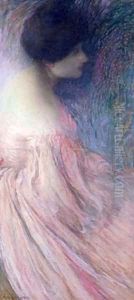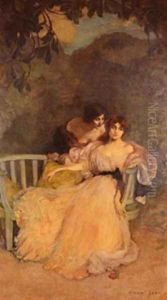Aman-jean Edmond Francois Paintings
Édouard François Aman-Jean, commonly known as Aman-Jean, was a French symbolist painter who was born in Chevry-Cossigny, Seine-et-Marne, on January 13, 1858. Aman-Jean was a distinctive artist of his time, known for his portraits and allegorical paintings that often depicted women in a mystical or serene ambiance, reflecting the influence of the Symbolist movement, which sought to represent ideas and emotions through symbolic imagery.
Aman-Jean studied at the École des Beaux-Arts in Paris and was a student in the studio of Alexandre Cabanel. He also worked closely with the renowned French painter Pierre Puvis de Chavannes, which left a lasting impact on his style and thematic choices. His early work was recognized when one of his pieces was accepted at the prestigious Paris Salon in 1885, a significant accomplishment for artists of the period.
His friendship with fellow student Georges Seurat led to his involvement with the Neo-Impressionist movement for a short period. Aman-Jean and Seurat shared a studio in Paris and influenced each other's work, though Aman-Jean did not adopt Seurat's pointillist technique. Instead, he developed a style characterized by soft, diffused contours and a subtle use of light and shading, which lent his works a dreamlike quality.
Throughout his career, Aman-Jean became known for his portraits, especially those of women, which often conveyed a sense of introspection and grace. He also created decorative panels, murals, and was involved in various projects that involved the integration of art and architecture. His work in public spaces includes murals for the Sorbonne and the Hôtel de Ville in Paris.
As an artist, Aman-Jean was not confined to painting alone; he also produced lithographs and was actively involved in the artistic community, advocating for the arts and serving on exhibition juries. He was recognized with numerous awards and honors, including the Legion of Honor in 1900.
Aman-Jean's work is held in various public collections, including the Musée d'Orsay in Paris. His legacy is that of a painter who bridged the gap between academic art and the emerging symbolist aesthetic that sought to capture the unseen and the emotional. Édouard François Aman-Jean passed away on January 25, 1936, leaving behind a body of work that continues to be appreciated for its poetic and evocative qualities.

